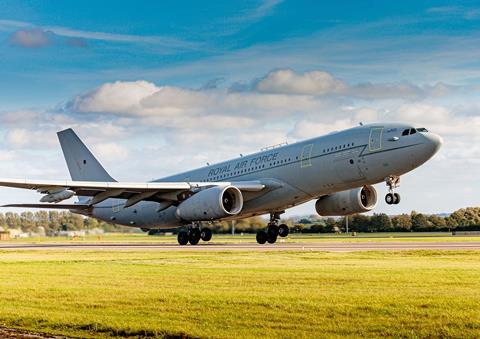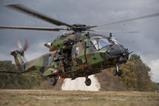Momentum is building among air forces eager to address climate change as one of their strategic priorities, after NATO described the issue as “a defining challenge of our time, with a profound impact on allied security”.
The UK Ministry of Defence (MoD) published its Defence Aviation Net Zero Strategy in mid-July 2023, supported by input from the nation’s Defence Suppliers Forum. Its key priority is to ensure that decarbonisation measures are in place to achieve the metric no later than 2050.
The initiative swiftly secured support as leading industry players including BAE Systems, Boeing, Leonardo and Rolls-Royce signed up to a related charter.

“As a company, an industry and a society we all have a part to play in tackling the threat of climate change and this charter is our latest commitment,” says Ian Muldowney, chief operating officer of BAE’s Air sector business.
For its part, the Royal Air Force (RAF) has already “launched an ambitious programme” to contribute toward the transition, within its next generation vision, dubbed Astra.
The service has already cleared all of its platforms to operate on a sustainable aviation fuel (SAF) blend of up to 50%, and has flown an Airbus Defence & Space A330 Voyager tanker entirely powered by SAF.
“Defence aviation emissions, attributable to the combustion of aviation fuel, contributed around 35% of the MoD’s total emissions in 2019/2020,” the report states. “Aviation emissions are not only the largest contributor, but they are also seen as some of the hardest to abate due to the significant technology challenges that are involved.”
MITIGATING OPTIONS
According to the MoD’s current assumptions, aviation-related carbon reduction will be achieved “through the combination of five mitigating options”.
Some 34% will come from the widespread introduction of SAF. “The predominant challenge will come in establishing robust supply chains to meet fuel demands,” the report states, with a 10% SAF uptake targeted for aviation by 2030.
A 30% saving will come from “improved technical and operational efficiency”, such as improved fuel-efficiency, and for example, emissions cuts made “from the point of taxi to the final parking position”.
Another 20% reduction will be achieved by “rethinking capability provision” – such as by shifting the RAF’s synthetic versus live training mix to a 70:30 ratio, and moving some applications to the use of uncrewed assets.
Carbon capture and storage will account for another 15%, including the ability “to create feedstocks for future synthetic [fuel] supply”.
“Through its significant estate, the RAF is aspiring for its holdings to become net negative by 2040, as a means to offset any remaining emissions,” the strategy document states.
Zero emissions propulsion is expected to deliver only a 1% contribution, since “current projections for the development of battery-electric technology suggest that they will be unable to meet the performance requirements for most defence aviation capabilities”. Hydrogen also “is unlikely to play a significant role in decarbonising fleets before 2040”, it adds.
INDUSTRY PARTNERSHIPS
Steve Gillard, Boeing’s regional director UK, Middle East and international defence sustainability, and co-chair of the Defence Suppliers Forum’s climate change and sustainability working group, says industry has a key part to play on the path to net-zero.
“We want to work with the MoD to make this a reality,” he says. “This is a first step, but [it] shows tangible progress, and that we’re really committed.
“It’s SAF, but not SAF exclusively,” he notes of current efforts involving the company.
The introduction of modern and more-efficient platforms will deliver improvements, such as replacing the RAF’s already retired Boeing E-3D Sentry airborne warning and control system fleet with a 737NG-based solution.
“Transitioning to the E-7 [Wedgetail] will bring lower operating and sustainment costs, higher mission readiness rates and unmatched interoperability,” Boeing says.
Other such examples include the US Air Force’s (USAF’s) tanker recapitalisation effort, which is delivering 767-based KC-46As as replacements for aged KC-135s.
“Because we are using less gas to move the aircraft around it means we’ve got more gas to give to the aircraft that are receiving fuel,” Gillard notes. “That is a win-win situation, while delivering lower emissions and lower costs.”
Re-engining the USAF’s Boeing B-52 bombers with R-R’s F130 powerplant also will deliver a 30% fuel efficiency improvement.
Meanwhile, more efficient operational use of Boeing’s C-17 strategic transport, enabled by data analytics and predictive maintenance, has already enabled Australia, Canada and the UK to save a combined “4.5 million-plus pounds of fuel over a six-year period”.
The airframer also has signed a framework agreement “to explore sustainable aviation opportunities” for the RAF’s nine-strong P-8A Poseidon MRA1 fleet.
COMPLEX LOGISTICS
Gillard notes that the move to SAF – which offers a 70-80% carbon reduction versus traditional fuel – plus potentially electric and hybrid propulsion, will create “a more complex logistics space”.
“Defence forces need to make sure that their platforms are capable of operating SAF to be interoperable with the commercial jet fuel supply chain.
“The first step is obviously to burn less fuel… and use the fuel that we have intelligently,” Gillard says. “If I’m an airline, that’s not just about emissions – that’s about profit. In the military world, that’s about range, time on station, as well as cost the taxpayer.

“There is huge opportunity in SAF for the military. By defence committing to SAF, it can accelerate some of the projects and get the volumes moving. If I can bring that fuel on shore, then I have surety of supply. I’m also protecting my nation against inflationary shocks.”
He quips: “When I took this role, I didn’t realise I was going to learn about two things: finance and farming.
“The finance community has a critical role to play in this: there are huge amounts of capital that can be deployed to support SAF production,” he notes.
“Where we do see supportive government policy, we’re seeing that money flow into SAF production, and it is scaling rapidly.” Examples include the US government’s Inflation Reduction Act, and an amendment in the UK Energy Bill. The latter will lead to the introduction by late 2026 of a so-called revenue certainty mechanism, to support SAF production in the UK.
Gillard says early action is already having an effect, although much work remains. “We’re on the road, but we just need to move a little bit faster.”































